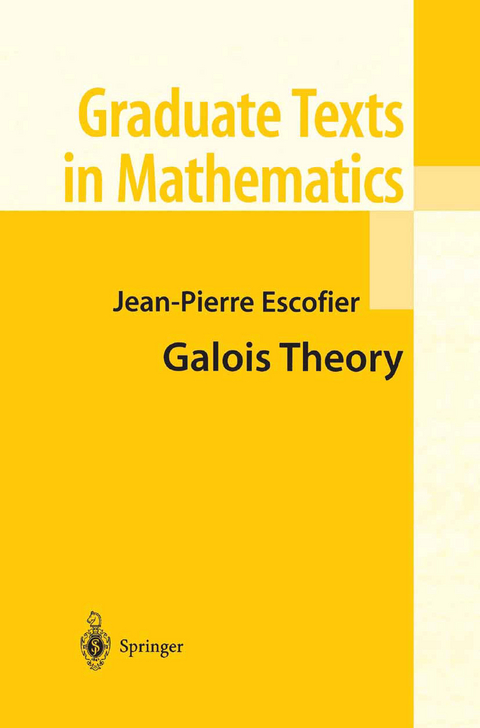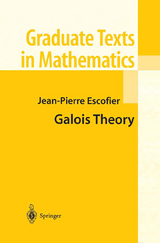Galois Theory
Springer-Verlag New York Inc.
978-0-387-98765-1 (ISBN)
- Titel ist leider vergriffen;
keine Neuauflage - Artikel merken
1 Historical Aspects of the Resolution of Algebraic Equations.- 1.1 Approximating the Roots of an Equation.- 1.2 Construction of Solutions by Intersections of Curves.- 1.3 Relations with Trigonometry.- 1.4 Problems of Notation and Terminology.- 1.5 The Problem of Localization of the Roots.- 1.6 The Problem of the Existence of Roots.- 1.7 The Problem of Algebraic Solutions of Equations.- Toward Chapter 2.- 2 Resolution of Quadratic, Cubic, and Quartic Equations.- 2.1 Second-Degree Equations.- 2.1.1 The Babylonians.- 2.1.2 The Greeks.- 2.1.3 The Arabs.- 2.1.4 Use of Negative Numbers.- 2.2 Cubic Equations.- 2.2.1 The Greeks.- 2.2.2 Omar Khayyam and Sharaf ad Din at Tusi.- 2.2.3 Scipio del Ferro, Tartaglia, Cardan.- 2.2.4 Algebraic Solution of the Cubic Equation.- 2.2.5 First Computations with Complex Numbers.- 2.2.6 Raffaele Bombelli.- 2.2.7 François Viète.- 2.3 Quartic Equations.- Exercises for Chapter 2.- Solutions to Some of the Exercises.- 3 Symmetric Polynomials.- 3.1 Symmetric Polynomials.- 3.1.1 Background.- 3.1.2 Definitions.- 3.2 Elementary Symmetric Polynomials.- 3.2.1 Definition.- 3.2.2 The Product of the X ? Xi; Relations Between Coefficients and Roots.- 3.3 Symmetric Polynomials and Elementary Symmetric Polynomials.- 3.3.1 Theorem.- 3.3.2 Proposition.- 3.3.3 Proposition.- 3.4 Newton’s Formulas.- 3.5 Resultant of Two Polynomials.- 3.5.1 Definition.- 3.5.2 Proposition.- 3.6 Discriminant of a Polynomial.- 3.6.1 Definition.- 3.6.2 Proposition.- 3.6.3 Formulas.- 3.6.4 Polynomials with Real Coefficients: Real Roots and Sign of the Discriminant.- Exercises for Chapter 3.- Solutions to Some of the Exercises.- 4 Field Extensions.- 4.1 Field Extensions.- 4.1.1 Definition.- 4.1.2 Proposition.- 4.1.3 The Degree of an Extension.- 4.1.4 Towers of Fields.- 4.2 The Tower Rule.- 4.2.1 Proposition.- 4.3 Generated Extensions.- 4.3.1 Proposition.- 4.3.2 Definition.- 4.3.3 Proposition.- 4.4 Algebraic Elements.- 4.4.1 Definition.- 4.4.2 Transcendental Numbers.- 4.4.3 Minimal Polynomial of an Algebraic Element.- 4.4.4 Definition.- 4.4.5 Properties of the Minimal Polynomial.- 4.4.6 Proving the Irreducibility of a Polynomial in Z[X].- 4.5 Algebraic Extensions.- 4.5.1 Extensions Generated by an Algebraic Element.- 4.5.2 Properties of K[a].- 4.5.3 Definition.- 4.5.4 Extensions of Finite Degree.- 4.5.5 Corollary: Towers of Algebraic Extensions.- 4.6 Algebraic Extensions Generated by n Elements.- 4.6.1 Notation.- 4.6.2 Proposition.- 4.6.3 Corollary.- 4.7 Construction of an Extension by Adjoining a Root.- 4.7.1 Definition.- 4.7.2 Proposition.- 4.7.3 Corollary.- 4.7.4 Universal Property of K[X]/(P).- Toward Chapters 5 and 6.- Exercises for Chapter 4.- Solutions to Some of the Exercises.- 5 Constructions with Straightedge and Compass.- 5.1 Constructible Points.- 5.2 Examples of Classical Constructions.- 5.2.1 Projection of a Point onto a Line.- 5.2.2 Construction of an Orthonormal Basis from Two Points.- 5.2.3 Construction of a Line Parallel to a Given Line Passing Through a Point.- 5.3 Lemma.- 5.4 Coordinates of Points Constructible in One Step.- 5.5 A Necessary Condition for Constructibility.- 5.6 Two Problems More Than Two Thousand Years Old.- 5.6.1 Duplication of the Cube.- 5.6.2 Trisection of the Angle.- 5.7 A Sufficient Condition for Constructibility.- Exercises for Chapter 5.- Solutions to Some of the Exercises.- 6 K-Homomorphisms.- 6.1 Conjugate Numbers.- 6.2 K-Homomorphisms.- 6.2.1 Definitions.- 6.2.2 Properties.- 6.3 Algebraic Elements and K-Homomorphisms.- 6.3.1 Proposition.- 6.3.2 Example.- 6.4 Extensions of Embeddings into ?.- 6.4.1 Definition.- 6.4.2 Proposition.- 6.4.3 Proposition.- 6.5 The Primitive Element Theorem.- 6.5.1 Theorem and Definition.- 6.5.2 Example.- 6.6 Linear Independence of K-Homomorphisms.- 6.6.1 Characters.- 6.6.2 Emil Artin’s Theorem.- 6.6.3 Corollary: Dedekind’s Theorem.- Exercises for Chapter 6.- Solutions to Some of the Exercises.- 7 Normal Extensions.- 7.1 Splitting Fields.- 7.1.1 Definition.- 7.1.2 Splitting Field of a Cubic Polynomial.- 7.2 Normal Extensions.- 7.3 Normal Extensions and K-Homomorphisms.- 7.4 Splitting Fields and Normal Extensions.- 7.4.1 Proposition.- 7.4.2 Converse.- 7.5 Normal Extensions and Intermediate Extensions.- 7.6 Normal Closure.- 7.6.1 Definition.- 7.6.2 Proposition.- 7.6.3 Proposition.- 7.7 Splitting Fields: General Case.- Toward Chapter 8.- Exercises for Chapter 7.- Solutions to Some of the Exercises.- 8 Galois Groups.- 8.1 Galois Groups.- 8.1.1 The Galois Group of an Extension.- 8.1.2 The Order of the Galois Group of a Normal Extension of Finite Degree.- 8.1.3 The Galois Group of a Polynomial.- 8.1.4 The Galois Group as a Subgroup of a Permutation Group.- 8.1.5 A Short History of Groups.- 8.2 Fields of Invariants.- 8.2.1 Definition and Proposition.- 8.2.2 Emil Artin’s Theorem.- 8.3 The Example of
% MathType!MTEF!2!1!+-
% feaagaart1ev2aaatCvAUfKttLearuqr1ngBPrgarmWu51MyVXgatC
% vAUfeBSjuyZL2yd9gzLbvyNv2CaeHbd9wDYLwzYbItLDharyavP1wz
% ZbItLDhis9wBH5garqqtubsr4rNCHbGeaGqiVu0Je9sqqrpepC0xbb
% L8F4rqqrFfpeea0xe9Lq-Jc9vqaqpepm0xbba9pwe9Q8fs0-yqaqpe
% pae9pg0FirpepeKkFr0xfr-xfr-xb9adbaqaaeGaciGaaiaabeqaam
% aaeaqbaaGcbaacbaGae8xuae1aamWaaeaadaGcbaqaaiabikdaYaWc
% baGaeG4mamdaaOGaeiilaWIaemOAaOgacaGLBbGaayzxaaaaaa!4235!
$$
Q/left[ {/sqrt[3]{2},j} /right]
$$ : First Part.- 8.4 Galois Groups and Intermediate Extensions.- 8.5 The Galois Correspondence.- 8.6 The Example of
% MathType!MTEF!2!1!+-
% feaagaart1ev2aaatCvAUfKttLearuqr1ngBPrgarmWu51MyVXgatC
% vAUfeBSjuyZL2yd9gzLbvyNv2CaeHbd9wDYLwzYbItLDharyavP1wz
% ZbItLDhis9wBH5garqqtubsr4rNCHbGeaGqiVu0Je9sqqrpepC0xbb
% L8F4rqqrFfpeea0xe9Lq-Jc9vqaqpepm0xbba9pwe9Q8fs0-yqaqpe
% pae9pg0FirpepeKkFr0xfr-xfr-xb9adbaqaaeGaciGaaiaabeqaam
% aaeaqbaaGcbaacbaGae8xuae1aamWaaeaadaGcbaqaaiabikdaYaWc
% baGaeG4mamdaaOGaeiilaWIaemOAaOgacaGLBbGaayzxaaaaaa!4235!
$$
Q/left[ {/sqrt[3]{2},j} /right]
$$: Second Part.- 8.7 The Example X4 + 2.- 8.7.1 Dihedral Groups.- 8.7.2 The Special Case of D4.- 8.7.3 The Galois Group of X4 + 2.- 8.7.4 The Galois Correspondence.- 8.7.5 Search for Minimal Polynomials.- Toward Chapters 9, 10, and 12.- Exercises for Chapter 8.- Solutions to Some of the Exercises.- 9 Roots of Unity.- 9.1 The Group U(n) of Units of the Ring ?/n?.- 9.1.1 Definition and Background.- 9.1.2 The Structure of U(n).- 9.2 The Möbius Function.- 9.2.1 Multiplicative Functions.- 9.2.2 The Möbius Function.- 9.2.3 Proposition.- 9.2.4 The Möbius Inversion Formula.- 9.3 Roots of Unity.- 9.3.1 n-th Roots of Unity.- 9.3.2 Proposition.- 9.3.3 Primitive Roots.- 9.3.4 Properties of Primitive Roots.- 9.4 Cyclotomic Polynomials.- 9.4.1 Definition.- 9.4.2 Properties of the Cyclotomic Polynomial.- 9.5 The Galois Group over Q of an Extension of Q by a Root of Unity.- Exercises for Chapter 9.- Solutions to Some of the Exercises.- 10 Cyclic Extensions.- 10.1 Cyclic and Abelian Extensions.- 10.2 Extensions by a Root and Cyclic Extensions.- 10.3 Irreducibility of Xp ? a.- 10.4 Hilbert’s Theorem 90.- 10.4.1 The Norm.- 10.4.2 Hilbert’s Theorem 90.- 10.5 Extensions by a Root and Cyclic Extensions: Converse.- 10.6 Lagrange Resolvents.- 10.6.1 Definition.- 10.6.2 Properties.- 10.7 Resolution of the Cubic Equation.- 10.8 Solution of the Quartic Equation.- 10.9 Historical Commentary.- Exercises for Chapter 10.- Solutions to Some of the Exercises.- 11 Solvable Groups.- 11.1 First Definition.- 11.2 Derived or Commutator Subgroup.- 11.3 Second Definition of Solvability.- 11.4 Examples of Solvable Groups.- 11.5 Third Definition.- 11.6 The Group An Is Simple for n ? 5.- 11.6.1 Theorem.- 11.6.2 An Is Not Solvable for n ? 5, Direct Proof.- 11.7 Recent Results.- Exercises for Chapter 11.- Solutions to Some of the Exercises.- 12 Solvability of Equations by Radicals.- 12.1 Radical Extensions and Polynomials Solvable by Radicals.- 12.1.1 Radical Extensions.- 12.1.2 Polynomials Solvable by Radicals.- 12.1.3 First Construction.- 12.1.4 Second Construction.- 12.2 If a Polynomial Is Solvable by Radicals, Its Galois Group Is Solvable.- 12.3 Example of a Polynomial Not Solvable by Radicals.- 12.4 The Converse of the Fundamental Criterion.- 12.5 The General Equation of Degree n.- 12.5.1 Algebraically Independent Elements.- 12.5.2 Existence of Algebraically Independent Elements.- 12.5.3 The General Equation of Degree n.- 12.5.4 Galois Group of the General Equation of Degree n.- Exercises for Chapter 12.- Solutions to Some of the Exercises.- 13 The Life of Évariste Galois.- 14 Finite Fields.- 14.1 Algebraically Closed Fields.- 14.1.1 Definition.- 14.1.2 Algebraic Closures.- 14.1.3 Theorem (Steinitz, 1910).- 14.2 Examples of Finite Fields.- 14.3 The Characteristic of a Field.- 14.3.1 Definition.- 14.3.2 Properties.- 14.4 Properties of Finite Fields.- 14.4.1 Proposition.- 14.4.2 The Frobenius Homomorphism.- 14.5 Existence and Uniqueness of a Finite Field with pr Elements.- 14.5.1 Proposition.- 14.5.2 Corollary.- 14.6 Extensions of Finite Fields.- 14.7 Normality of a Finite Extension of Finite Fields.- 14.8 The Galois Group of a Finite Extension of a Finite Field.- 14.8.1 Proposition.- 14.8.2 The Galois Correspondence.- 14.8.3 Example.- Exercises for Chapter 14.- Solutions to Some of the Exercises.- 15 Separable Extensions.- 15.1 Separability.- 15.2 Example of an Inseparable Element.- 15.3 A Criterion for Separability.- 15.4 Perfect Fields.- 15.5 Perfect Fields and Separable Extensions.- 15.6 Galois Extensions.- 15.6.1 Definition.- 15.6.2 Proposition.- 15.6.3 The Galois Correspondence.- Toward Chapter 16.- 16 Recent Developments.- 16.1 The Inverse Problem of Galois Theory.- 16.1.1 The Problem.- 16.1.2 The Abelian Case.- 16.1.3 Example.- 16.2 Computation of Galois Groups over ? for Small-Degree Polynomials.- 16.2.1 Simplification of the Problem.- 16.2.2 The Irreducibility Problem.- 16.2.3 Embedding of G into Sn.- 16.2.4 Looking for G Among the Transitive Subgroups of Sn.- 16.2.5 Transitive Subgroups of S4.- 16.2.6 Study of ?(G) ? An.- 16.2.7 Study of ?(G) ? D4.- 16.2.8 Study of ?(G) ? ?/4?.- 16.2.9 An Algorithm for n = 4.
| Reihe/Serie | Graduate Texts in Mathematics ; 204 |
|---|---|
| Übersetzer | L. Schneps |
| Zusatzinfo | 28 Tables, black and white; XIV, 283 p. |
| Verlagsort | New York, NY |
| Sprache | englisch |
| Maße | 155 x 235 mm |
| Gewicht | 1330 g |
| Themenwelt | Literatur ► Biografien / Erfahrungsberichte |
| Mathematik / Informatik ► Mathematik ► Algebra | |
| Mathematik / Informatik ► Mathematik ► Arithmetik / Zahlentheorie | |
| Naturwissenschaften ► Physik / Astronomie | |
| ISBN-10 | 0-387-98765-7 / 0387987657 |
| ISBN-13 | 978-0-387-98765-1 / 9780387987651 |
| Zustand | Neuware |
| Haben Sie eine Frage zum Produkt? |
aus dem Bereich




